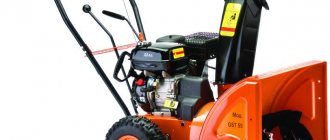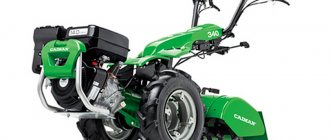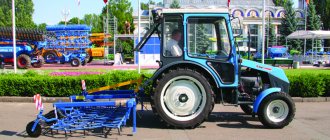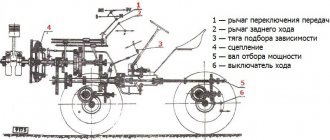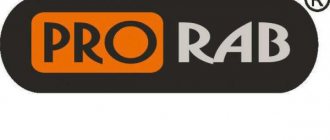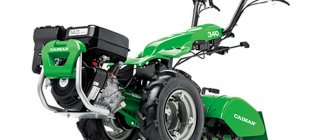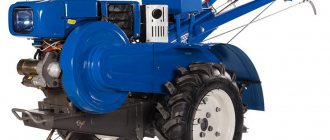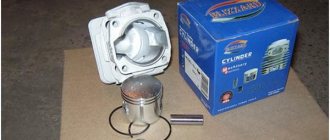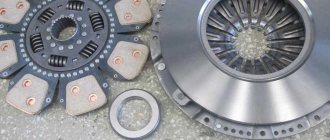The Foreman cultivator is a modern amateur-class device designed for cultivating soil on personal plots and small farms. The Prorab brand, which produces equipment, is part of the A-CLASS GROUP holding, which is considered one of the most successful multi-brand companies in the domestic market. In addition to motor cultivators, the Foreman brand produces power tools, garden equipment, construction equipment and accessories.
The enterprise complies with the requirements and standards of ISO 9001, which indicates the high quality of its products, which is duly appreciated by residents of Russia, Kazakhstan and the Republic of Belarus.
Foreman cultivators can be serviced in specialized service centers of the A-CLASS GROUP holding, which has a certificate of conformity with ROSTEST of Russia.
Let's consider the strengths and weaknesses of the manufactured equipment, as well as the available options for modernizing the design.
Features of application
The manufacturer recommends using 92 octane gasoline and SAE 15W40 oil for the Foreman GT 709 SK walk-behind tractor.
The lubricant should be replaced according to the schedule given in the instructions.
The first replacement is carried out after running-in, which is carried out immediately after purchase or after a long period of inactivity.
The break-in itself does not take much time. By adhering to the following steps, you will be able to properly run-in, thereby ensuring that all parts are ground in:
- Check the oil and fuel levels in the tanks. If a shortage is detected, it is necessary to top up.
- During the first 4 hours, the engine should run at idle speed. But it is impossible to work for more than 20 minutes, so it is necessary to carry out programming, increasing the speed for a short time to the maximum.
- For the next 4 hours, the cultivator can be used, but load no more than 50% of its full capacity.
- Upon completion of the break-in, drain the used oil and fill with new oil.
The schedule for maintenance work is presented in the user manual.
- The oil should be changed every 25 hours of operation of the device.
- The transmission oil must be changed after 100 operating hours.
- Control levers must be lubricated with Litol or Solidol once a month for their smooth operation.
- After the end of the work season, the Foreman GT 709 SK walk-behind tractor must be preserved, namely: cleaned of dirt, wiped dry, drained fuel and oil, lubricated the working parts, covered with a cloth and left in a dry place until work is resumed.
More details about the operating features of the Foreman GT 709 SK walk-behind tractor can be found in the instructions—>
User manual
The operating instructions recommend using the walk-behind tractor for processing medium and heavy soils.
When raising virgin soil, it is necessary to take breaks to cool down the power plant.
The product manual regulates the following rules for its use:
- Run-in. This procedure is carried out immediately after purchase or before the first entry into the field. First, the correct gear shift is checked, then the engine is cranked by hand. Then the engine starts and idles for 40-60 minutes. Then, for 12 hours, the product is loaded at half the rated power.
- Before each visit to the site and after completion of work, a control inspection is carried out. The appearance of the machine is checked for mechanical damage. The chassis and cooling system are cleaned of dirt. If necessary, add or replace oil.
- After every hour of operation it is necessary to stop and turn off the walk-behind tractor. When lifting virgin soil or transporting heavy loads, technological breaks should be taken after 20-30 minutes. Overheating the engine can cause costly damage.
- If the unit is not planned to be used in winter, then it is preserved. The spark plug is unscrewed, oil is poured into the cylinder, and the hole is closed with a rag. All metal parts are coated with thick lubricant. The product is covered with thick material to protect it from ultraviolet radiation and dust.
You can store the walk-behind tractor outdoors under a canopy or in a dry, ventilated shed.
General information, purpose and design features
The Prorab GT 65 BT cultivator is widely in demand among summer residents, farmers and gardeners. In addition, the technology has proven itself well in the public utilities sector. The machine has decent performance, comparable to more high-end walk-behind tractors. The device is designed to perform work related to cultivation, hilling and plowing of soil. You can also form beds, pump water, transport loads, and work with deep soil.
The equipment is very convenient in everyday use. The adjustable handle allows you to choose a comfortable position for your height. Thus, thanks to this, the car can be recommended to people of any size.
The GT 65 BT foreman is manufactured in China from Chinese components. This significantly reduces the cost of production, and at the same time the cost of the cultivator. This may explain the high demand for the model. Most owners rate the reliability of the car positively, but there are a number of shortcomings. For example, a walk-behind tractor is not famous for its great endurance, especially if it is constantly used in difficult conditions - off-road, and when cultivating virgin lands, transporting heavy loads, etc. Any overload negatively affects the reliability of the unit. In normal mode, the device is quite durable and is capable of satisfying its owner. But we must admit that the model is made of cheap parts that are not adapted to long-term extreme load. These shortcomings are compensated by the low cost of spare parts.
At the same time, the technique has undeniable advantages characteristic of compact and heavier cultivators:
- Excellent maneuverability and smooth ride
- Sharp steering, comfortable grip handle
- Low cost of ownership
- The delivery set includes cultivation cutters - from four to six pieces
- Low fuel consumption
- Possibility of turning 180 degrees
- Transport wheel – facilitates transportation of the cultivator. If necessary, the wheel can be removed to, for example, make it more convenient to transport it in the trunk of a car.
- The main controls responsible for controlling the gas, brake, clutch and gear shift are located on the handle.
- Availability of various mounts for installing mounted options
- Possibility of transporting cargo weighing up to 600 kg
- Adaptability to large temperature changes. The engine is equipped with a preheater and an air cooling system, which ensures trouble-free starting in hot or frosty weather.
- Low octane gasoline support
- Thanks to its compact dimensions, the equipment is easy to maneuver in tight spaces, as well as when avoiding obstacles
- The owner can choose the necessary attachments himself. This may explain its absence in the basic configuration. We can say that in this way the manufacturer expresses his concern for the owner.
- Some stores offer a discount on the cultivator along with additional options
Device
The motor cultivator is assembled from alloy steel and durable polymer plastic.
The machine consists of the following parts and mechanisms:
- Engine. The manufacturer installs a four-stroke gasoline engine with one cylinder and air cooling on the car. For ease of starting in cold weather, the engine is equipped with a pre-heater.
- Frame. It is a durable steel structure assembled using arc welding. The metal is resistant to corrosion and mechanical stress.
- Chassis. Consists of a drive axle, pneumatic wheels and a gearbox. When working with cutters, a removable support wheel is used. Torque is transmitted through a collapsible gearbox and high-quality drive belts.
- Steering. The dual lever features buttons and levers that are easy to reach from any position. The handle is adjustable in angle and height.
- Casing. Made of bright green plastic. Protects the operator from the heat of the engine and clods of earth flying out from under the working parts.
- Brackets for attachments and power take-off shaft. These devices are adapted to work with Russian and Chinese-made options.
With high productivity, the cultivator has compact dimensions. It can be transported in the trunk of a car.
Attachments for walk-behind tractors Foreman
For proper operation of Foreman cultivators, it is important to select the right attachments. Lightweight, low-power cultivators are suitable exclusively for plowing, cultivating and loosening the soil; installation of additional attachments is not provided for them
Models with more powerful engines from 6.5 hp. rationally aggregated with additional devices, capable of effectively performing various agrotechnical and economic work. The range of mounted attachments is quite wide and allows you to turn the Foreman cultivator into a multifunctional machine:
- plows of various modifications – double-row, reversible
- hillers
- weeders
- harrows
- potato planters and potato diggers
- motor pump
- adapter with seat
- mini carts and trailers
- metal lugs
- weights
- sweeping brushes
- blade shovel.
Planting potatoes using the cultivator Foreman GT 71 SK
In addition, the model range of Prorab cultivators has special design and technological specifics - many different machine options have been developed with a varied combination of basic soil cultivation parameters: working width / tillage depth. Therefore, focusing on these indicators, each owner will be able to choose the most optimal model for himself, based on the characteristics of the soil being processed, the type of crops grown, and other needs.
Attachments
To successfully operate mounted mechanisms with a motor cultivator, you should make a rational choice so as not to increase the load on the engine and not to deteriorate the quality of work. Lightweight, low-power models of Prorab cultivators are not capable of working with additional mounted implements; their functionality is limited to loosening and light plowing of the soil.
Motor cultivator Foreman GT 71 SK works with attachments:
Unlike other brands, TM Prorab offers many different options for combining the “width/depth” parameters when processing soil with cutters. Thanks to this, owners have the opportunity to choose the optimal models of Foreman cultivators necessary for growing certain crops and performing special work.
Cultivators Foreman with 6.5 hp gasoline engines. and above successfully cope with a number of tasks - they plow virgin soil with ease, and are used in conjunction with a double-row plow, a wide harrow, and a potato digger.
The hiller works effectively in combination with the cultivator Foreman GT 732 SK when hilling potatoes and other tuber plants. A single-row plow will perform deep plowing of the soil. The pump is used for pumping water, and pumping units are used for irrigation. With a harrow it is convenient to cut furrows and prepare beds.
Planting potatoes using a motor cultivator Foreman GT 71 SK:
On powerful models it is possible to install adapters to make work easier. Using a universal hitch, a trolley is connected to transport cargo. Metal wheels with lugs and weights will provide the Prorab cultivator with good maneuverability on difficult soil. Brushes, shovels, blades, and other accessories will significantly expand the options of your cultivator.
Functionality also increases when using mowers, potato planters and hillers, and in winter, a snow blower and tracks.
Attachments
The Prorab company has launched the production of attachments for motor cultivators, which are presented in a huge assortment. Hiller. This device is especially popular among owners of potato fields. With its help, you can remove weeds and hill up potato rows, while forming high and neat ridges. A potato digger and potato planter are also often used by summer residents when planting and harvesting potatoes. The devices greatly facilitate the heavy physical labor that is usually associated with growing this crop.
The cutters are designed for loosening the soil, removing weeds and cultivating virgin lands. For motor cultivators, saber-shaped models are mainly used, although for powerful samples the use of “crow’s feet” is allowed. The adapter is a metal frame with a seat and is designed to allow the operator to operate the cultivator while sitting. This function can be very useful when transporting goods and when processing large areas. The mower is designed for preparing feed for cattle, removing weeds and mowing lawns.
A single-row plow allows you to plow virgin lands and is capable of penetrating 25-30 cm deep into the soil. For more powerful plows, the use of double-row options is allowed. The harrow is used to level the land when preparing it for sowing or wintering. A pump is necessary for pumping or transferring liquids and is often used in combination with sprinklers for watering plantations.
However, when choosing a motor cultivator, it should be taken into account that most of the attachments listed above can be used with models with a power of over 6 hp. With. This applies to the plow, adapter and cart. Therefore, before purchasing a motor cultivator, it is necessary to determine the volume and type of work, and only after that choose both the unit itself and the attachments.
Service
The GT-715 SK foreman consumes AI-92 gasoline and oil, the manufacturer recommends SAE 15W40 class. Before work, it is recommended to always check the oil and gasoline levels, test the reliability of fastenings of moving joints and bolts, check the tire pressure, and the tension of the drive belt.
Preventative work consists of timely replacement of consumables, engine oil after 25 hours of operation, transmission oil after 100 hours. Parts and assemblies that require lubrication are treated with universal water-repellent lubricants Litol and Solidol at least once a month. Before long-term storage, fuel and oil are drained, the Foreman walk-behind tractor is thoroughly cleaned of dirt, wiped dry with a rag, coated with lubricant, and the valves are closed.
Advantages and disadvantages
Like any agricultural machinery, the Prorab cultivator has both strengths and weaknesses. The advantages include economical fuel consumption, which has a positive effect on the budget, and very easy operation of the unit. The device is highly maneuverable and smooth, and the height-adjustable handles allow you to adjust it to your height. In addition, the manufacturer provides a guarantee of protection against accidental fire of the unit, which makes its use absolutely safe.
For ease of use, the cultivator is equipped with a lighting system, which allows you not to stop working after dark. Many consumers also note the convenient location of the main keys and control levers located on the handle, which makes it possible to easily switch gears, control the gas and brake. The advantages include the ability of the cultivator to work in conditions of high and low temperatures - this allows it to be used in the range from -10 to 40 degrees.
However, such units have their drawbacks. These include the low endurance of mechanisms when working with virgin soil, as well as rapid overheating of the motor when transporting loads weighing over 500 kg. To be fair, it should be noted that models of this class are not intended for particularly heavy loads, and in such cases it is better to use a walk-behind tractor.
The lineup
The Prorab company produces light, medium and heavy equipment for earthworks.
The most popular model is the Foreman GT 65 BT K.
The machine has the following advantages and characteristics:
- good maneuverability and smooth ride;
- comfortable steering;
- economical fuel consumption (2.2 l/h);
- possibility of turning around on the spot;
- work on all types of gasoline;
- affordable price and large selection of spare parts;
- ease of maintenance.
The car has 2 forward and 1 reverse gears. When working on medium soil, it provides a grip of 65 cm, a loosening and plowing depth of 30 cm. With a walk-behind tractor weighing 50 kg, it is capable of towing trailers weighing up to 600 kg.
The GT 21 model falls into the category of ultra-light equipment. The machine weighs only 15 kg and can easily be driven by a teenager or a pensioner. The units are used for loosening the soil and hilling up beds. The Foreman motor-cultivator has a 2.2 hp gasoline engine, which is enough to cultivate soil to a depth of 20 cm with a working width of 40 cm. The gearbox has 1 forward and 1 reverse gear.
The Foreman GT 40T walk-behind tractor is designed for working on medium-heavy soil. The machine is equipped with a 4.0 liter power unit. With. and a gearbox with 1 forward and 1 reverse speed. The working width is 38 cm with a loosening depth of 25 cm. Pneumatic wheels with a wide tread provide the equipment with good maneuverability.
Heavy walk-behind tractors of the GT 715 SK model are used in conjunction with an adapter or trailer, as they weigh 250 kg. Having an engine power of 13 hp. pp., the technique is used for loosening and plowing soil. The working width is 85 cm and the depth is 30 cm. The gearbox has 4 forward and 2 reverse speeds. On a flat road the car can accelerate to 12 km/h.
Operation and Maintenance
Recommendations for operating Prorab cultivators, first start-up, running-in, and performing routine maintenance are detailed in the operating instructions. The cultivator engines run on high-quality AI-92 gasoline and SAE 10W-30 motor oil is used.
Operating instructions for the Prorab GT 55 BT/ Prorab GT 65 BT cultivator.
Run-in
Before running the cultivator, you must check all components and connections and tighten the bolts if necessary. Next, the car is filled with fuel and lubricant. During the running-in period - duration 20 hours, all components and mechanisms are ground in and working gaps are calibrated.
When running in, the unit should not operate at maximum speed; after 2 hours of continuous operation, it is necessary to take a 15-minute break to allow the engine to cool. You should visually monitor the functioning of systems, monitor the condition of moving parts and components. Upon completion of the break-in process, the engine oil is replaced with fresh one; in the future, the engine oil is replaced after 100 operating hours.
Basic faults
Often, difficulties in the operation of Foreman cultivators arise due to violation of the recommended operating modes, the use of low-quality fuels and lubricants, and non-compliance with the preventive inspection schedule.
If the engine does not start, the reason may be:
- Lack of gasoline or oil;
- Fuel or air filters are clogged;
- Problems with the ignition system (the terminals have come off the spark plugs or carbon deposits have formed on them);
- Incorrect carburetor setting.
If the unit vibrates strongly during operation:
- Perhaps you are working with too heavy soil;
- Looseness of bolted connections of the unit itself;
- The hitch is not secured correctly;
- The drive belt has become unusable.
Sometimes when operating motor cultivators, owners are faced with the fact that the machine buries itself in the ground. This could be due to a number of reasons.
- The total weight of the cultivator with cutters does not correspond to the quality of the soil. Light machines are usually equipped with 4 heavy cutters; when working on loose soil, sinking occurs. In this case, you need to remove the outer knives from the cutters, and install a weight at the rear of the cultivator for balance.
- Switching the machine to second gear is not always appropriate when operating on loose soil. If there is a reverse, you need to use it to pull out the cultivator, or do it manually.
- Due to improper installation of cutters, the machine can also become buried. They should be reinstalled in accordance with the instructions at the appropriate angle, taking into account the direction of the knives forward.
Following the manufacturer's recommendations will help you effectively process your site and protect your equipment from premature breakdowns, searching for spare parts and costly repairs.
Sergey Vasechkin, Samara:
“Very good cultivator Foreman 55, I bought it on sale, the price is normal. I use it in spring and autumn for plowing and weeding. Our plot is small, the soil is loose, and 5.5 hp is enough power.”
Alexander:
“Cultivator foreman 65 W(t). With normal maintenance it works quite reliably. Clean the air filter and change the oil once a season. The plastic gears are hidden under the casing, I think there should be no wear. The motor runs smoothly without any strain. Among the shortcomings: the handles are not adjustable in height, a little inconvenient. And during the run-in, the spark plug immediately flew off.”
Features of service, operation
Foreman cultivators consume high-quality AI-92 gasoline and SAE 10W-30 class motor oil. The features of the device, operation, and adjustments of the motor cultivator can be found in the factory operating instructions at the link.
The following must be checked daily or every 5 hours of operation:
- fuel level in tank
- amount of engine oil
- reliability of fastenings and threaded connections
- correct assembly and connection of components
- cable tension
- presence of technical fluid leaks
- presence of lubricant in the gearbox.
Run-in, first launch
For Prorab cultivators, the break-in procedure is mandatory. Before the first start-up, check the reliability of the fastenings, the condition of all systems, components and mechanisms, and fill with fuel and engine oil. Then, for 20 hours, the cultivator is operated at reduced speeds in a gentle mode. During this period, the final grinding of parts and assemblies and calibration of the working gap takes place.
During the break-in period, it is necessary to take breaks of 15 minutes after two-hour periods of operation to cool the engine. At the end of the break-in, the air filter is cleaned and the engine oil is replaced with new one. In the future, the oil is changed after 100 hours of operation.
Basic malfunctions, repair of walk-behind tractors Foreman
Thanks to a rational, well-thought-out design, cultivators are not prone to system breakdowns and malfunctions. Problems mainly arise due to violation of the operating instructions, the use of low-quality fuel, inappropriate motor oil, and failure to comply with the maintenance schedule.
You should always remember that Foreman cultivators require frequent breaks in operation to cool down, since the motors are sensitive to overheating. It is especially important to maintain a work-rest regime under intense loads on heavy soils, otherwise repairs are inevitable.
Due to their light weight, the Foreman cultivators can bury themselves in the soil when plowing. From the experience of owners, this can happen for the following reasons:
- Incorrect installation of rototillers - you should refer to the factory instructions and reinstall the rotors correctly with the knives facing forward.
- The weight of the machine and installed cutters does not correspond to the quality of the soil. Typically, this problem is typical for lightweight models that are equipped with two pairs of cutters. In this case, the Foreman should leave one cutter on each side on the cultivator and attach a weighting agent.
- When working on soft ground, it is not advisable to operate in second gear.
Construction of the walk-behind tractor Foreman GT-100 RDKe
The simple, well-thought-out design of the Foreman walk-behind tractor ensures easy operation, minimal maintenance, and affordable repairs.
- Thanks to the electric starter, the Foreman walk-behind tractor starts easily and is able to work even at subzero temperatures.
- An expanded gearbox with 6 forward and 2 reverse speeds allows you to choose a rational pace of work depending on the type of connected attachments.
- A durable gear reducer is installed on the walk-behind tractor.
- The presence of water cooling of the engine allows the machine to operate in hot weather.
- The ergonomic control handles are adjustable; all the necessary control levers for the unit are conveniently located on them.
- Enlarged fuel tank with a capacity of 6 liters. makes it possible to operate the walk-behind tractor for a long time without refueling.
- Excellent maneuverability is ensured by large pneumatic wheels with high tread.
- For work in the dark, Prorab is equipped with a powerful headlight.
Electric cultivators
PRORAB ET 1456
| Supply voltage, V | 230 |
| Drive power, W | 1450 |
| engine's type | Single phase electric |
| Processing width per pass, mm | 400 |
| Number of cutters | 6 |
| Number of speeds | 1 forward |
Compact and lightweight model designed for processing small areas with soft soil. Excellent maneuverability allows you to perform work with high precision. Due to the absence of harmful exhausts, the model can be used for loosening soil in greenhouses.
PRORAB ET 754
| Supply voltage, V | 220 |
| Drive power, W | 750 |
| engine's type | Single phase electric |
| Processing width per pass, mm | 300 |
| Number of cutters | 4 |
| Number of speeds | 1 forward |
The lightest model in the line, which even the elderly can handle. The device will do an excellent job of loosening pre-treated soil. Compact dimensions and high maneuverability allow you to work in flower beds, greenhouses and flower beds.
Video
- Denis, Moscow region. An excellent cultivator for little money. I've been using it for four months. Ideal for processing a summer cottage area of 6 acres. The unit is assembled from high-quality materials - at least there were no major breakdowns. But 4 months is a short period of time, so we’ll see how the technology behaves further. I would like to note the standard wheels, which provide good cross-country ability on off-road and muddy ground. There is support for 92 gasoline. By the way, the car consumes only 1 liter per hour. I use it 4-5 hours a day.
- Boris, Tver region. An excellent cultivator for everyday tasks. Hilling, cultivating, mowing, transporting goods - all these works with the Foreman are carried out with high efficiency, and at the same time the device is undemanding in terms of fuel quality and consumes no more than 1.5 liters per hour.
- Oleg, Nikolaev. I liked the unit. I received the GT 65 BT foreman as a gift from the work team - for good services, so to speak. We work as farmers, we have large professional walk-behind tractors, up to full-fledged tractors. And this Foreman was useful to me for housekeeping. The machine effectively cultivates, processes complex hard soils, and can also pump water. If there is a lack of power or a lack of weight, I install lugs, and the problem disappears by itself.
- Kirill, Petropavlovsk. I have a lot in common with this cultivator. I got the GT 65 BT foreman from my father. The car will be five years old in 2018, but it is still running. I service it in the garage. Unfortunately, breakdowns occur regularly. But the spare parts are cheap, otherwise I would have sold it long ago.
- Vladislav, Irkutsk. A cultivator for all occasions. I use it 8 hours a day. I have a garden of 26 acres, there is enough work. Perhaps the Foreman is working to the limit of his capabilities. I really feel it, even sometimes the engine stalls for no reason at all. But I was pleased with the consumption of 1 liter per hour.
- Dmitry, Yaroslavl. I use the GT 65 BT for transporting goods, cleaning areas and cultivating the soil by hilling, plowing, etc. The cultivator is very good for planting and digging up root crops. The engine runs almost silently, and there are almost no vibrations. But the wheels quickly become clogged with soil; they need to be cleaned regularly.
